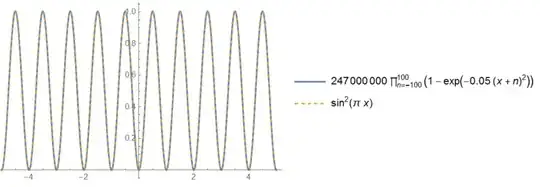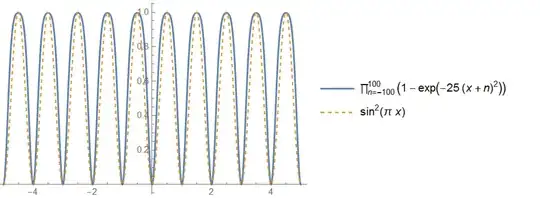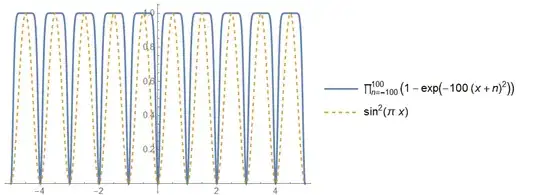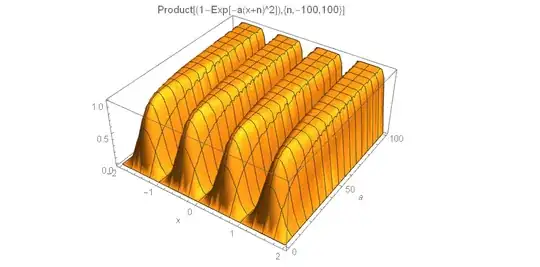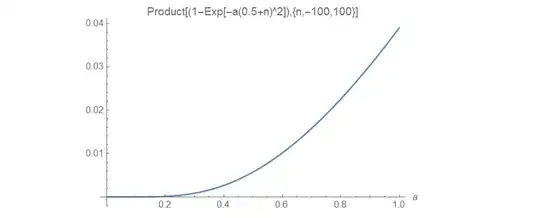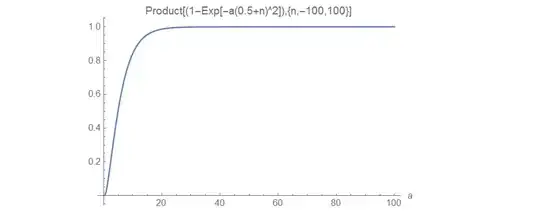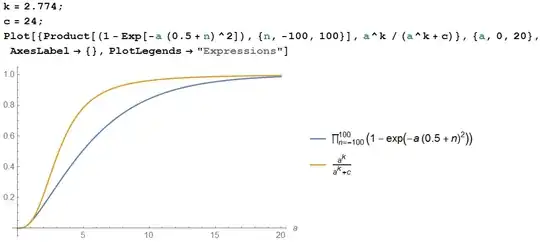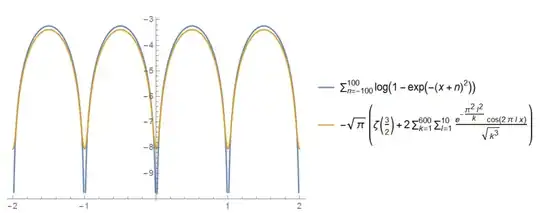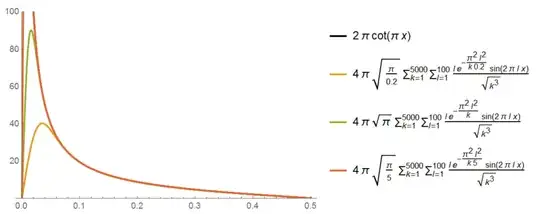While playing on pruduct series, I noticed interesting function that it has similar behavior to $C\cdot\sin^2(\pi x)$ function . I need help about some results below.
$$f(x)=\prod\limits_{n=-\infty}^{ \infty }(1-e^{-a{(x+n)^2}}) $$ where $a>0$
The function is a periodic function because
$$f(x+1)=\prod\limits_{n=-\infty}^{ \infty }(1-e^{-a{(x+1+n)^2}}) =\prod\limits_{n=-\infty}^{ \infty }(1-e^{-a{(x+n)^2}}) $$
Some properties of the function:
- $f(x+1)=f(x)$ Period is $1$
- It is obvious that $f(k)=0$ where $k$ is integer.
- It is even function. $f(-x)=f(x)$
These properties above are same as $C.\sin^2(\pi x)$
My ideas and my aim to find out about the function are
- Can we express it as known functions?
- How closed form of $f(\frac{1}{2})$ can be found? I believe that the function behaves the same as $C\sin^2(\pi x)$ has and $f'(\frac{1}{2})=0$ but I could not prove it.
- If it is a periodic function, what is the Fourier series expansion of the function?
Any reference links about the function and help will be appreciated very much .
Thanks
UPDATE: I proved my conjecture above , $f'(\frac{1}{2})=0$
I added some extra information too
$$\frac{f'(x)}{f(x)}=2a\sum\limits_{n=-\infty}^{ \infty } \frac{x+n}{e^{a{(x+n)^2}}-1} $$
$$\frac{f'(\frac{1}{2})}{f(\frac{1}{2})}=2a\sum\limits_{n=-\infty}^{ \infty } \frac{\frac{1}{2}+n}{e^{a{(\frac{1}{2}+n)^2}}-1} $$
$$\frac{f'(\frac{1}{2})}{f(\frac{1}{2})}=a\sum\limits_{n=-\infty}^{ \infty } \frac{2n+1}{e^{a{(\frac{1}{2}+n)^2}}-1}$$
$$f'(\frac{1}{2})=af(\frac{1}{2})\sum\limits_{n=-\infty}^{ \infty } \frac{2n+1}{e^{a{(\frac{1}{2}+n)^2}}-1}$$
$$f'(\frac{1}{2})=af(\frac{1}{2})\sum\limits_{n=-\infty}^{ -1 } \frac{2n+1}{e^{a{(\frac{1}{2}+n)^2}}-1}+af(\frac{1}{2})\sum\limits_{n=0}^{ \infty } \frac{2n+1}{e^{a{(\frac{1}{2}+n)^2}}-1}$$
$$f'(\frac{1}{2})=af(\frac{1}{2})\sum\limits_{k=0}^{ \infty } \frac{-(2k+1)}{e^{a{(-1)^2(\frac{1}{2}+k)^2}}-1}+af(\frac{1}{2})\sum\limits_{n=0}^{ \infty } \frac{2n+1}{e^{a{(\frac{1}{2}+n)^2}}-1}$$
$$f'(\frac{1}{2})=-af(\frac{1}{2})\sum\limits_{k=0}^{ \infty } \frac{2k+1}{e^{a{(\frac{1}{2}+k)^2}}-1}+af(\frac{1}{2})\sum\limits_{n=0}^{ \infty } \frac{2n+1}{e^{a{(\frac{1}{2}+n)^2}}-1}$$
$$f'(\frac{1}{2})=0$$
There can be proved in same way that
$f'(\frac{2k+1}{2})=0$ where $k$ is integer.
UPDATE: Nov 13th
I tried to used roots of $1-e^{-a{(x+n)^2}}$ . I would like to share my results. Maybe it can be helpful to find out an expression with known functions.
$$1-e^{-a{(x+n)^2}}=0$$ roots are:
$$a{(x+n)^2}=2k\pi i$$ Where $k$ integer.
If $k=0$
Roots $x=-n$ where $n$ is integer as known. for $k=0$ and They are double roots ,Thus
$$\prod\limits_{n=-\infty}^{ \infty }1-e^{-a{(x+n)^2}}=x^2\prod\limits_{n=1}^{ \infty }(1-\frac{x^2}{n^2})^2\prod\limits_{n=-\infty}^{ \infty }G(x,a)$$
$$f(x)=\frac{\sin^2 (\pi x)}{\pi^2}\prod\limits_{n=-\infty}^{ \infty }G(x,a)$$
$\prod\limits_{n=-\infty}^{ \infty }G(x,a)$ will be expressed by other roots for $k\neq 0$
$$\prod\limits_{n=-\infty}^{ \infty }G(x,a)=\prod\limits_{n=-\infty}^{ \infty }\prod\limits_{k=1}^{ \infty }(1-\frac{x}{-n+\sqrt{\frac{2k \pi i }{a}}})(1-\frac{x}{-n-\sqrt{\frac{2k \pi i }{a}}})(1-\frac{x}{-n+\sqrt{\frac{-2k \pi i }{a}}})(1-\frac{x}{-n-\sqrt{\frac{-2k \pi i }{a}}})$$
$$\prod\limits_{n=-\infty}^{ \infty }G(x,a)=\prod\limits_{n=-\infty}^{ \infty }\prod\limits_{k=1}^{ \infty }(1+\frac{2nx}{n^2-\frac{2k \pi i }{a}}+\frac{x^2}{n^2-\frac{2k \pi i }{a}})(1+\frac{2nx}{n^2+\frac{2k \pi i }{a}}+\frac{x^2}{n^2+\frac{2k \pi i }{a}})$$
$$\prod\limits_{n=-\infty}^{ \infty }G(x,a)=\prod\limits_{n=-\infty}^{ \infty }\prod\limits_{k=1}^{ \infty }(\frac{(x+n)^2-\frac{2k \pi i }{a}}{n^2-\frac{2k \pi i }{a}})(\frac{(x+n)^2+\frac{2k \pi i }{a}}{n^2+\frac{2k \pi i }{a}})$$
So finally we can write ;
$$f(x)=\frac{\sin^2 (\pi x)}{\pi^2}\prod\limits_{n=-\infty}^{ \infty }\prod\limits_{k=1}^{ \infty }(\frac{(x+n)^4+\frac{4\pi^2 k^2 }{a^2}}{n^4+\frac{4 \pi^2 k^2 }{a^2}})$$
I thought to change product order can help us, so to get
$$f(x)=\frac{\sin^2 (\pi x)}{\pi^2}\prod\limits_{k=1}^{ \infty }\prod\limits_{n=-\infty}^{ \infty }(\frac{(x+n)^4+\frac{4\pi^2 k^2 }{a^2}}{n^4+\frac{4 \pi^2 k^2 }{a^2}})$$
I am till here for now, But I do not see how to go from here to get a nice expression with known functions.
Thanks for helps
EDIT: 1/9/2017
After @Yuriy S 's wonderful graphics, I realized that we may express the $f(x,a)$ in approximation.
$$f(x,a)=\prod\limits_{n=-\infty}^{ \infty }(1-e^{-a{(x+n)^2}}) $$ where $a>0$
Known values of $f(x,a)$:
- $f(x,0)=0$
- $\lim_{a\to\infty} f(x,a)=1$
- $f(1/2+k,a)$ has maximum, where $k$ is integer
- $f(k,a)=0$, where $k$ is integer
- $f(x,a)$ is periodic function over $x$
I conjecture that $f(x,a) \approx \cfrac{a^k \sin^2(\pi x)}{a^k \sin^2(\pi x)+c}$ ,where $a>0$, $k,c$ are positive real numbers,
From Graphics below, I calculated $k$ and $c$.
in sixth graph,
$$f(1/2,1)\approx 0.04$$ $$f(1/2,0.6)\approx 0.01$$
From these results, I got $k$ and $c$.
$k \approx 2.774$ and $c \approx 24$.
Maybe someone can help me to calculate $k$ and $c$ more accurately.
Thanks Best Regards

